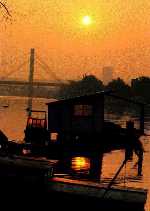 |
| Part 3 | Belgrade School of Life |
| Once more life was beautiful: all a creative person had to do was
imagine a work of art, and the work in it original form would be put
into circulation, without any censorship, editorial intervention, or
problems with execution and uninspired collaborators! Members of the
Belgrade School went to work "producing" tons of fiction, essays, and
experimental work, with some unavoidable memoirs and travelogues. There
was also plenty of "really dangerous political writing," all of it left
to the famous northerly koshawa wind to take it up and down the Danube
river in search of an eager recipient.
|
 |
As for the "people's masses", they were deprived of
the unexecuted masterpieces and rightly so: the
father of modernism himself wrote AN ENEMY OF THE
PEOPLE to prove the majority is never right. Hesse,
on the other hand, wrote that exceptional souls
recognize each other and have ways of communicating
with each other beyond mere language. And Colin
Wilson, regarded by many in Belgrade as a distant
and not so successful of Koestler, explains that
only some five percent of our planet's populace are
independent thinkers, capable of leading others and
having broader views.
|
 |
Like every movement, the Belgrade School of Life
had its traitors and those who took its teachings
in a less orthodox way and tried to make
compromises. But the hard core nucleus of the
movement dealt harshly with these heretics: they
were not allowed to join the common table at the
better Belgrade bars and clubs or, if allowed into
the circle thanks to their ability to buy a round
or two of drinks, they were not allowed to
contribute significantly to the discussions. Upon
entering a Belgrade bar, it is usually easy to
figure out which table belongs to the members of
the School; the noise that emanates from the group
is the sign of every writer's eternal dilemma:
whether to live or to write: to devote more time
to writing or to living one' life to the fullest.
|
[ 1 ]
[ 2 ]
[ 3 ]
[ 4 ]
|
| As the author is all for anonymity, we'll respect his wishes to stay unknown and omit
his name from this text. However, the above article appeared in Volume 17 #2 of the
San Francisco Review of Books, for Fall 1992. The author of TRUE WEST and some
other plays is on the cover, dressed as a cowboy. |
 |